Nota bene: All products in this article are independently selected and vetted by InsideHook editors. If you buy something, we may earn an affiliate commission.
If you’re watch shopping online, the Shinola Mechanic — a brand new model from the Detroit brand which features a manual-wind movement for the first time ever — likely won’t jump out at you. It incorporates a rounded square case, leaning into cushion territory, which separates it from the mostly traditional circular cases on offer in their other styles like the Runwell and Monster. But the clean dials in colors that won’t jump off the wrist (cream, black and olive) don’t necessarily pop off the screen either.
That’s odd, considering the hand-wound Mechanic is named not for mechanics of the grease-stained variety, but paint-stained “mechanics,” a nickname used by Detroit sign painters. It’s the job of these old-school artisans to beckon customers in with graphic hypnosis done up in eye-popping colors, so where’s that visual punch in this tribute?
Thankfully I was able to get my hands on a Mechanic before the launch, and what was missing for me in the flat-lay photos I initially received was found once I had it in my possession. I opted for the most interesting of the bunch: the olive green dial with goldenrod numbers outlined in blaze orange, accompanied by an olive leather strap. In person, the fiery border of the numbers, which lifts up the inner fill, and the subtle red shadowing are brought to life in the light, and the extra texture brought about by the circular shadows cast by the bubbled case and domed sapphire crystal make this just a plain fun watch to look at all day (Shinola is known for joy-inducing design).
Let’s dig into the specs. While the stainless steel case of the Shinola Mechanic does come in at just 39mm, the squared shape makes it wear bigger, so I wouldn’t worry about this feeling too small if you’re normally a 40mm and up type of person. The Swiss-made, 19-jewel Sellita SW210-1 movement is a manual wind, which means to power this three-hand piece up you’ll need to twist the lightning-bolt stamped crown clockwise until you feel it resist — and then you’ll need to twist it periodically later on to keep it ticking.
One design element that works well in this watch that I find completely unnecessary in many other watches of late is the open caseback. Shinola is trying its hand at its first hand-wound timepiece here, which means for many customers this will also be their first manual-wind watch (as Shinola tends to attract those who aren’t already watch geeks, though they may be a gateway drug), and being able to see the gears go from stock-still to churning, ticking and spinning away is a good way to feel that strapping on an old-school timepiece like this is worth foregoing that Apple Watch.
Because we’re dealing with a mechanical movement here (instead of Shinola’s signature quartz), it’s in the upper end of the brand’s price range. While most of their automatic watches top this style’s $1,450 price tag, you can pick up a few (like the blaze orange Lake Huron Monster Automatic and the Runwells) for $100 to $355 less. So is it worth it? Paying more for a timepiece you have to manually wind every morning? Like hand-painted signage, it’s worth it to those who don’t mind slowing down a little to appreciate the finer things.
We've put in the work researching, reviewing and rounding up all the shirts, jackets, shoes and accessories you'll need this season, whether it's for yourself or for gifting purposes. Sign up here for weekly style inspo direct to your inbox.
